As opposed to the previous day when it was sunny, this day it rained. Also, as opposed to the previous day when we walked a little and ate a lot, this day we walked a lot, but the quantity of food we put into ourselves continued to be impressive. Simply, Istanbul is not the place to go to when you are on any kind of diet – the food is exceptional wherever you eat, while the prices are not too high. On the other hand, even the so-called “fast food” is very good quality and tasty here.
But, let me go back to the cultural and historic part of our programme. For this day I prepared a very ambitious plan and the places we visited and the approximate routes may be seen in the following map:
To start with, we passed by Valens Aqueduct, then we continued along Atatürk Boulevard towards the Golden Horn and then we climbed uphill in the direction of the Zeyrek Mosque. Still, first we came across a local market. There, no matter where you turn, food seems to be all around you in Istanbul. I remember this market as the only place where we found unshelled pistachios – it’s a nice thing to treat oneself to without bothering with the shells.
At the time of Byzantium Zeyrek Mosque was a church that constituted a part of the Pantocrator Monastery which was, as the name suggests, dedicated to Christ. The construction of the church was started at the beginning of the 12th century by Empress Irene, but the empress died before the completion of the works and thus the church was finished by her husband Emperor John II Komnenos. Mosaic portraits of this royal couple may be seen in Hagia Sophia and the photo of that mosaic is incorporated into a text I have already posted on my blog (https://www.svudapodji.com/en/istanbul-2/).
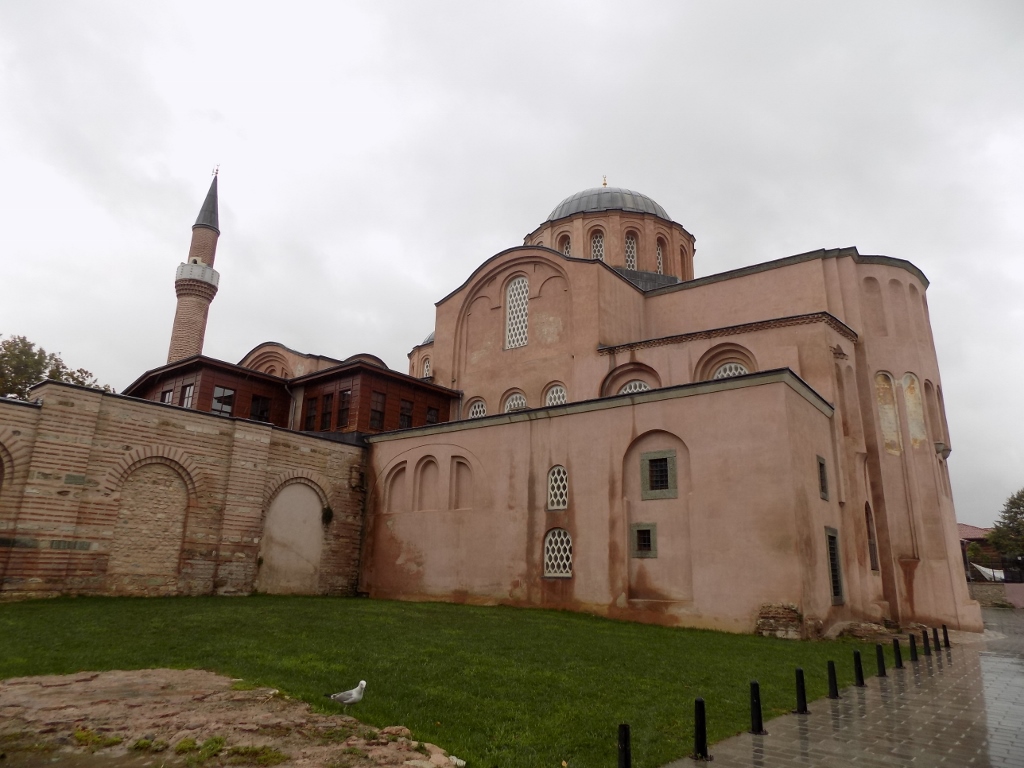 Zeyrek Mosque
Zeyrek Mosque
After the completion of this church, Emperor John II Komnenos ordered the construction of yet another church on the north side dedicated to the Mother of God Eleousa (the Merciful) and then by the year 1136 he had these two churches connected with a chapel dedicated to St. Michael, thus creating a unique spiritual space and getting the second largest church in Byzantine Constantinople (after Hagia Sophia). I have already encountered this, in my mind, quite interesting architectural bend-over-backwards endeavour where three churches are connected laterally into a unique space and this was in Cyprus at the monastery of St. John in Kalopanagiotis (https://www.svudapodji.com/en/cyprus-5/).
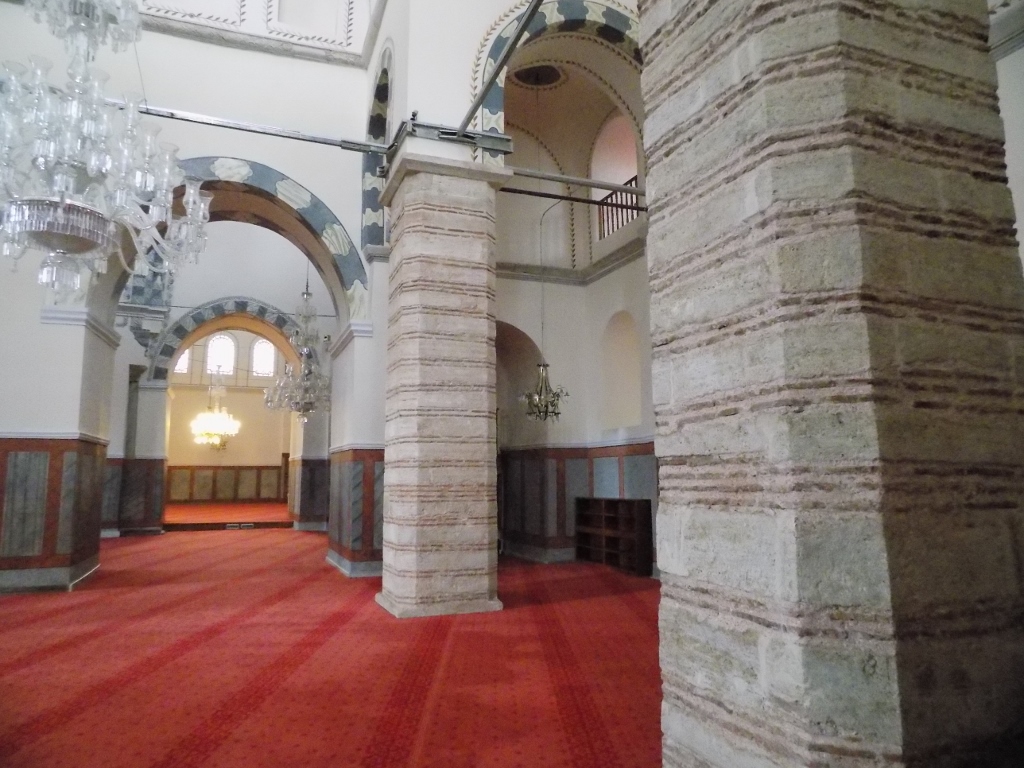 Zeyrek Mosque, view at the interior of all three churches – in the back there is the space of the former church dedicated to the Pantocrator
Zeyrek Mosque, view at the interior of all three churches – in the back there is the space of the former church dedicated to the Pantocrator
The monastery was exceptionally important at the time of Byzantium, it used to incorporate a library and a hospital, and this was also the place where the founding rulers, as well as a couple of other rulers and dignitaries were buried. When it was turned into a mosque after 1453, a madrasa, i.e., a school was founded here. Nowadays, the mosque bears the name precisely of one of the teachers who used to work there and that was Molla Zeyrek.
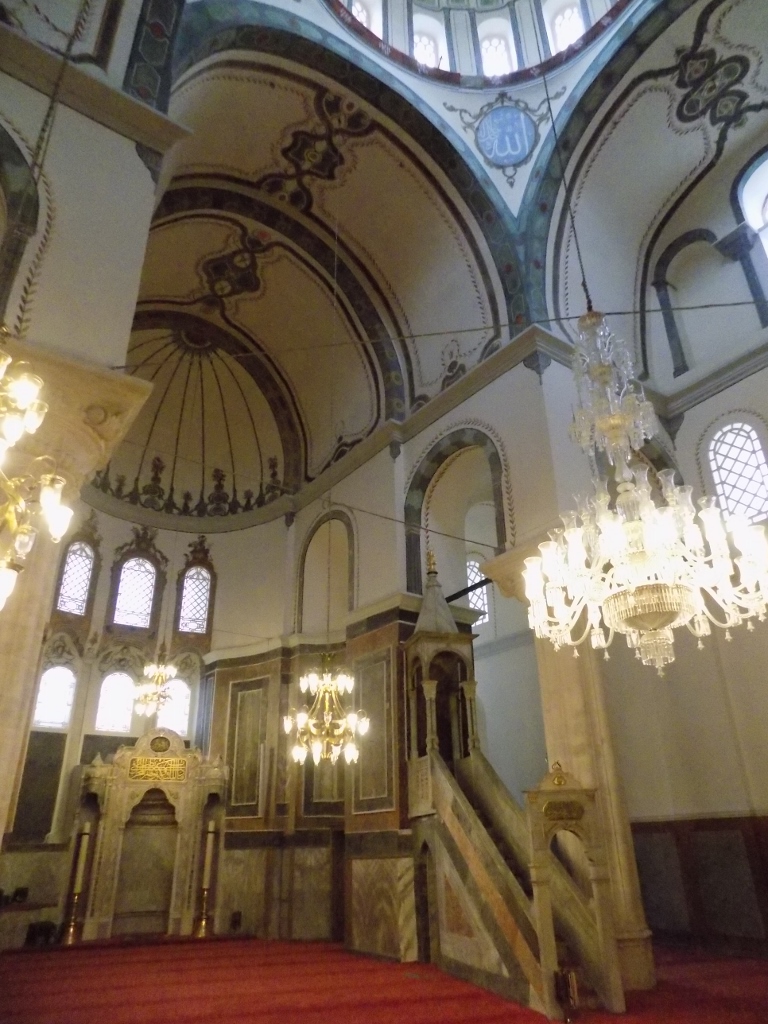 Zeyrek Mosque, a detail from the interior
Zeyrek Mosque, a detail from the interior
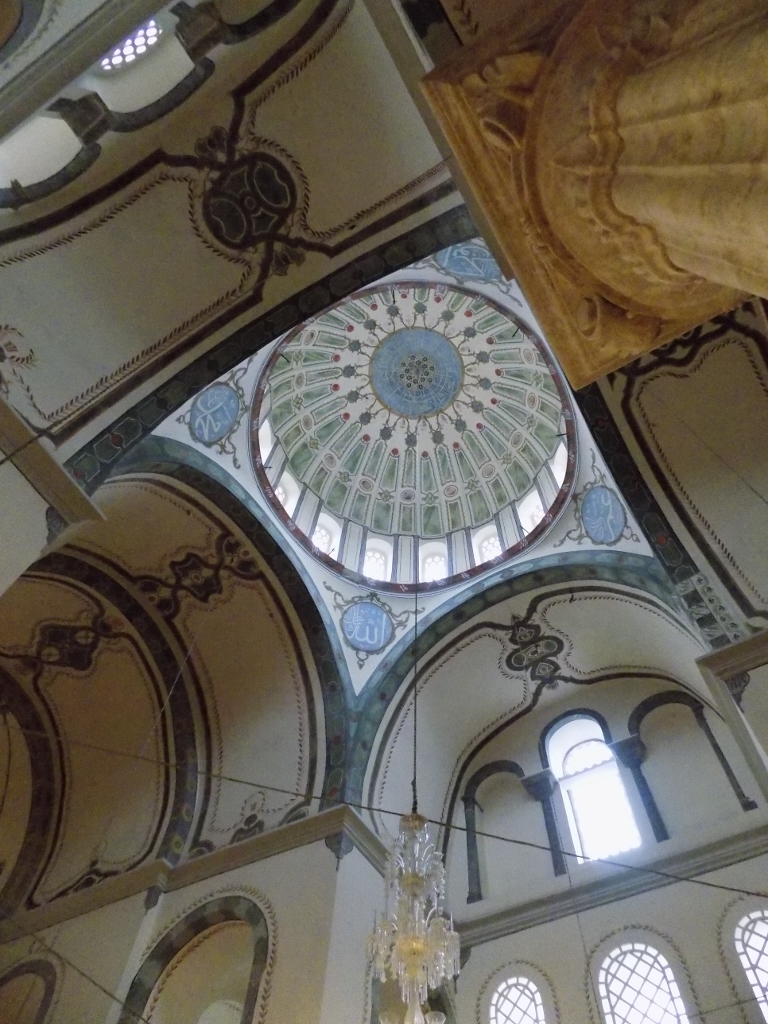 Zeyrek Mosque, a detail from the interior
Zeyrek Mosque, a detail from the interior
Already in the second half of the 15th century the significance of this spiritual place as a madrasa started to wane when some others were built in the vicinity, but it continued to function as a smaller Islamic monastery. However, a strong earthquake seriously damaged the edifice in 1766 and it was only at the beginning of the 21st century that it was properly restored.
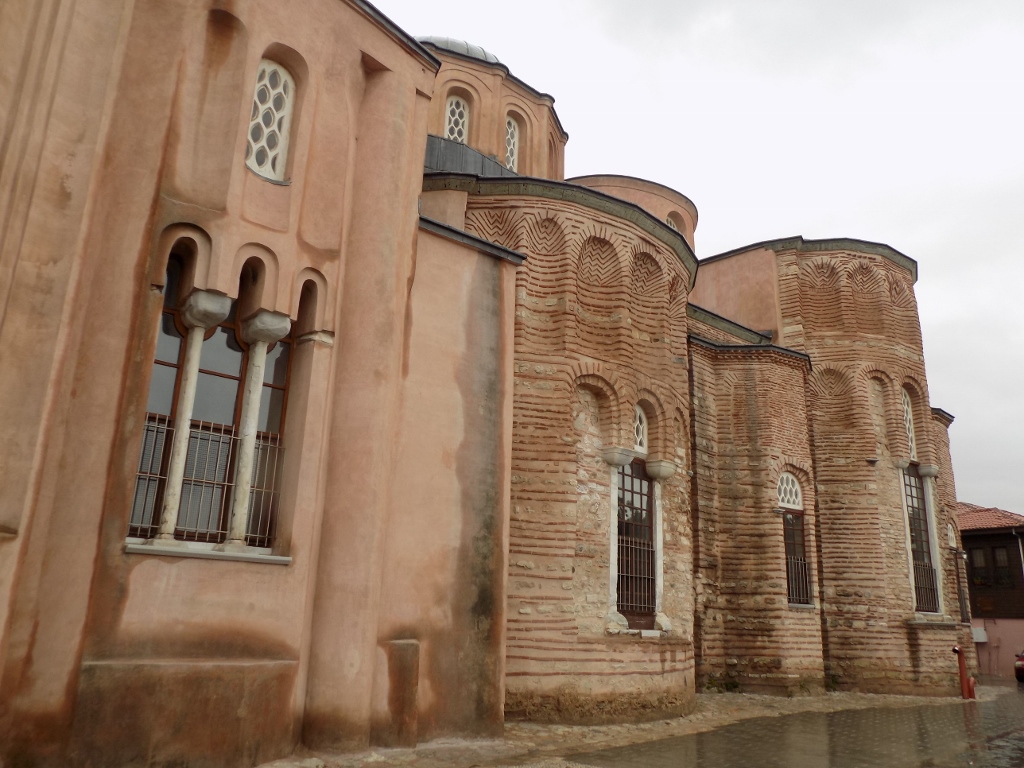 Zeyrek Mosque, the exterior part of the mosque where segments of different churches may be seen
Zeyrek Mosque, the exterior part of the mosque where segments of different churches may be seen
Following this visit we went back to the part of the city called Eminönü and there, in the lower sections of the quarter we passed through streets in which there were numerous shops. I can report that juice made of freshly squeezed pomegranate was just as tasty here as in any other place, but significantly less expensive. Then these “numerous shops in the streets” turned into a full-fledged market.
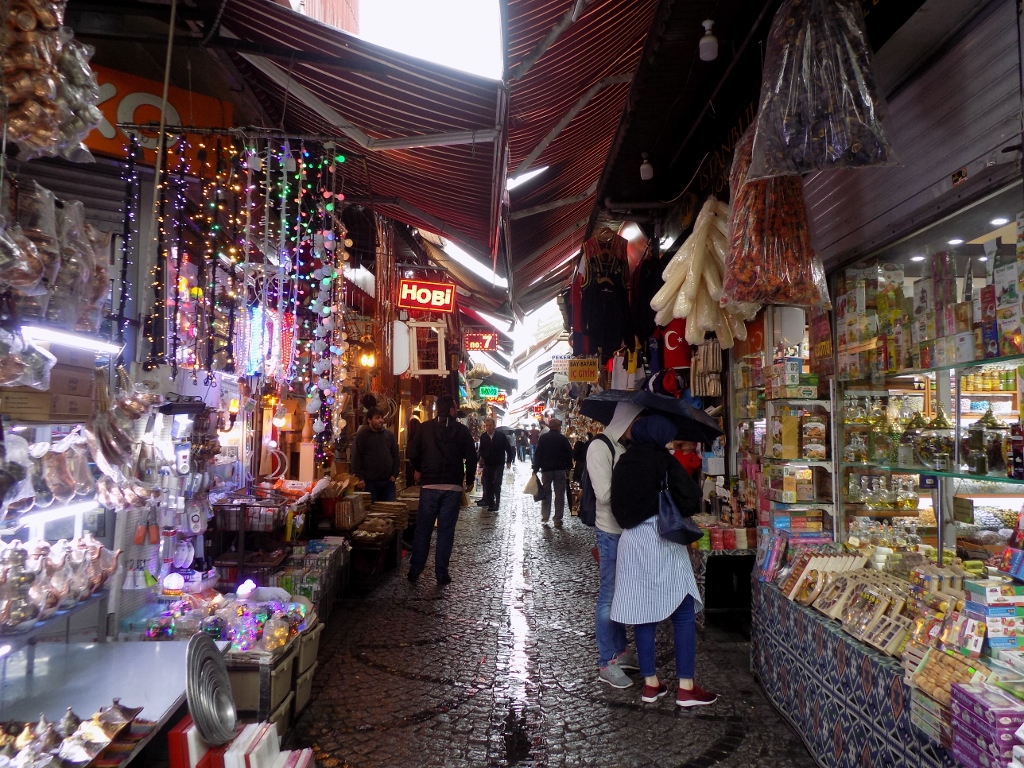 A market in Eminönü
A market in Eminönü
In addition to the shops, there are also small restaurants here as well and I was particularly impressed by the roasting of chicken drumsticks on a massive scale.
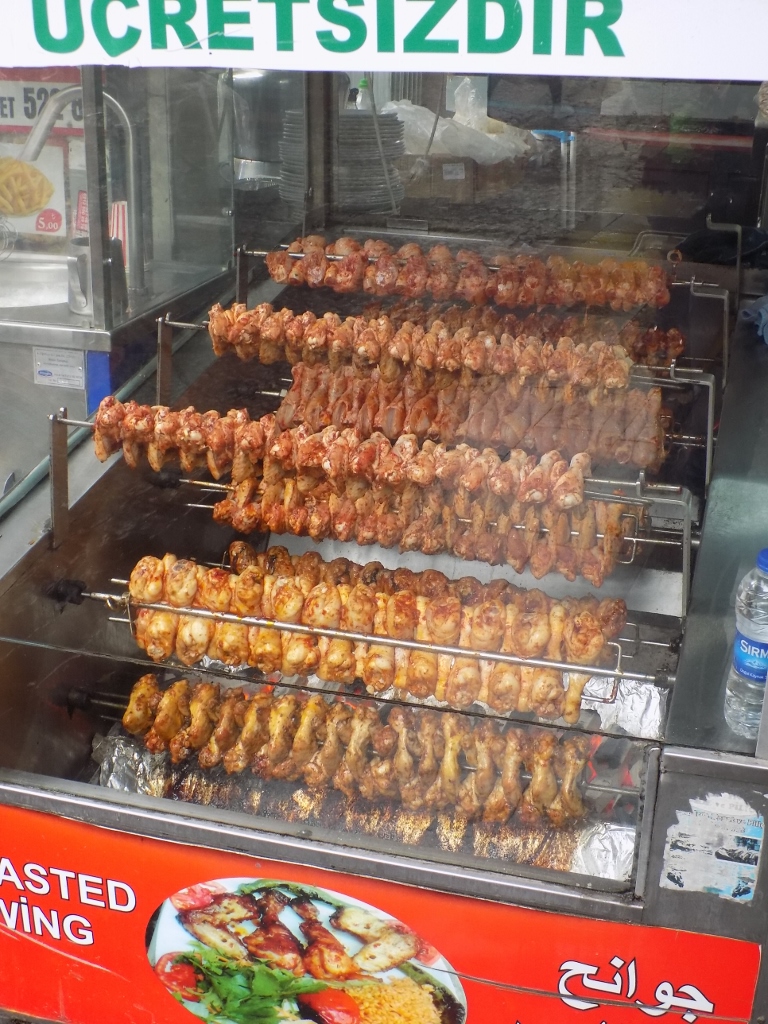 Revolving apparatus for the slow roasting of chicken drumsticks
Revolving apparatus for the slow roasting of chicken drumsticks
There were other interesting things as well, such as these wreaths of dried peppers, tomatoes and aubergines that are used for stuffing, cooking and eventually for eating.
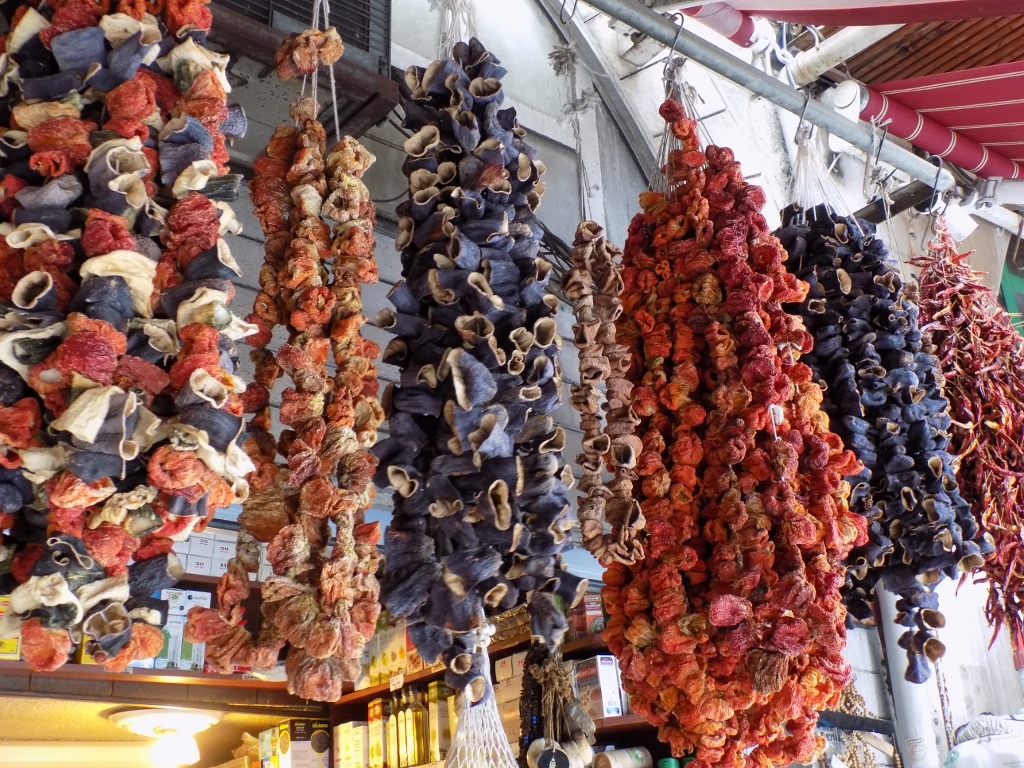 Wreaths of dried vegetables used in cooking
Wreaths of dried vegetables used in cooking
The two of us, however, ate here only some fantastically big and tasty dry dates, since we had some other food-related plans.
On the other hand, the main reason for coming to this part of the city was to visit a couple of mosques – Rüstem Paşa Camii and the New Mosque or Yeni Cami. We had a slight problem locating Rüstem Paşa Mosque since it is completely surrounded and somehow squeezed with the market, but we did find it eventually. However, it was closed for tourist visits since there was an ongoing restoration and only the believers were allowed in as it continued to serve as a functional mosque.
Very close there is yet another important mosque and this is the New Mosque that was also undergoing restoration at the time of our visit, but it was possible to go in.
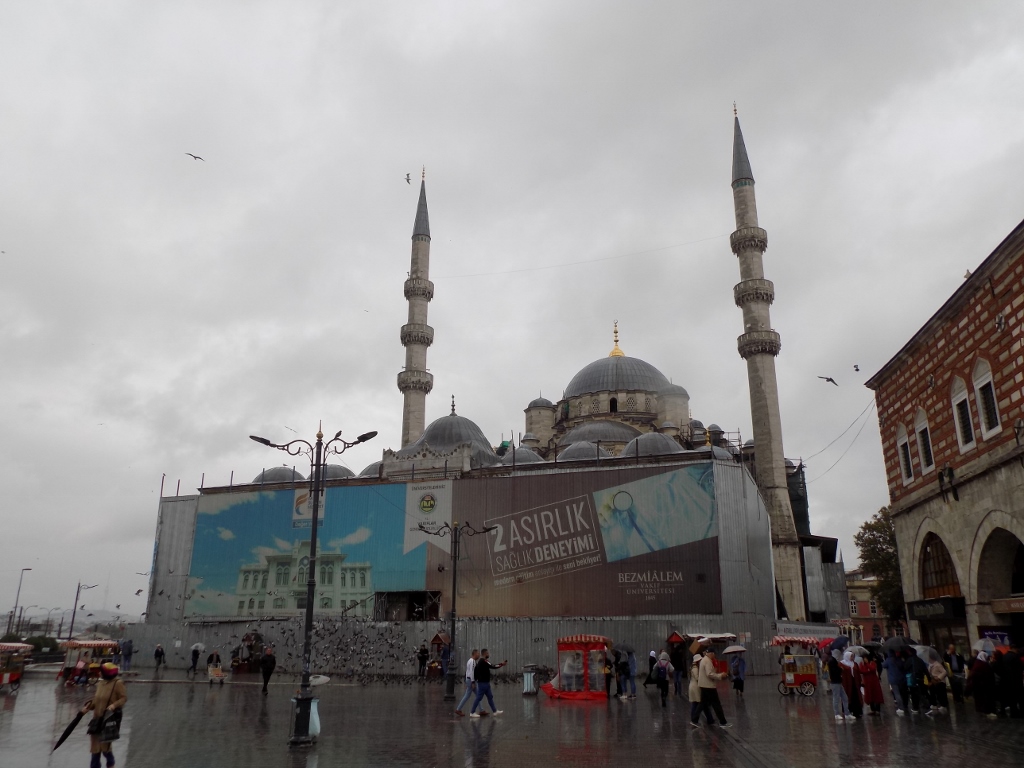 New Mosque
New Mosque
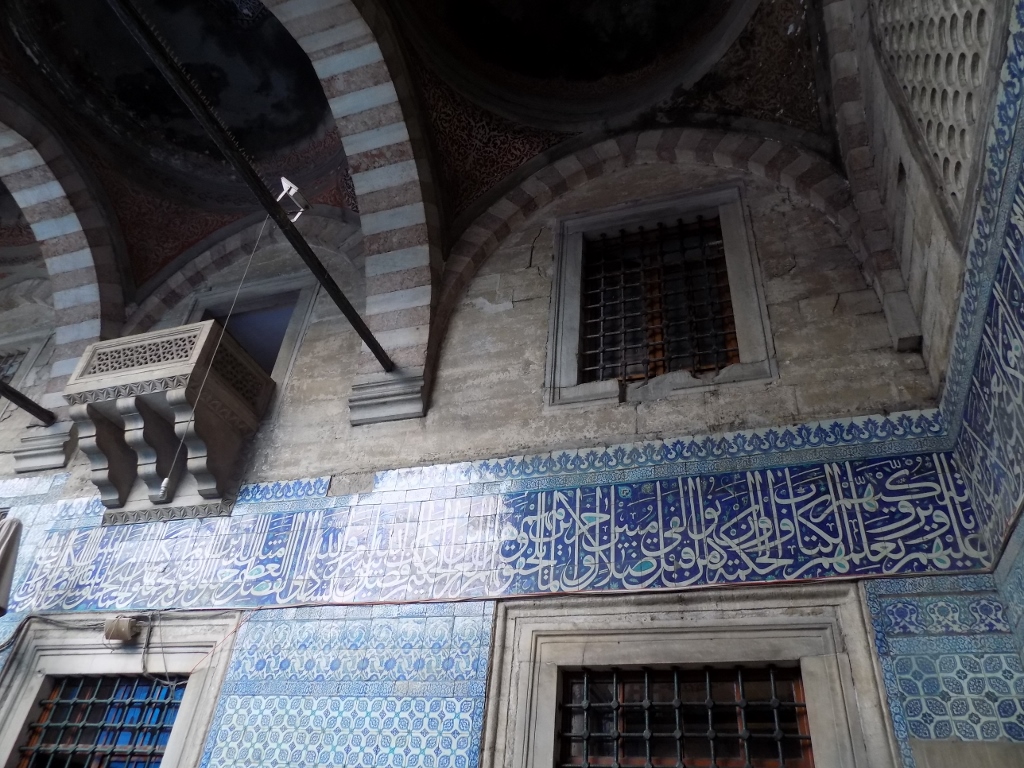 New Mosque, impressive decoration of the exterior part of the mosque
New Mosque, impressive decoration of the exterior part of the mosque
Still, because of the panels that covered almost the entire interior of the mosque, everything seemed rather modest and we did not stay there for long.
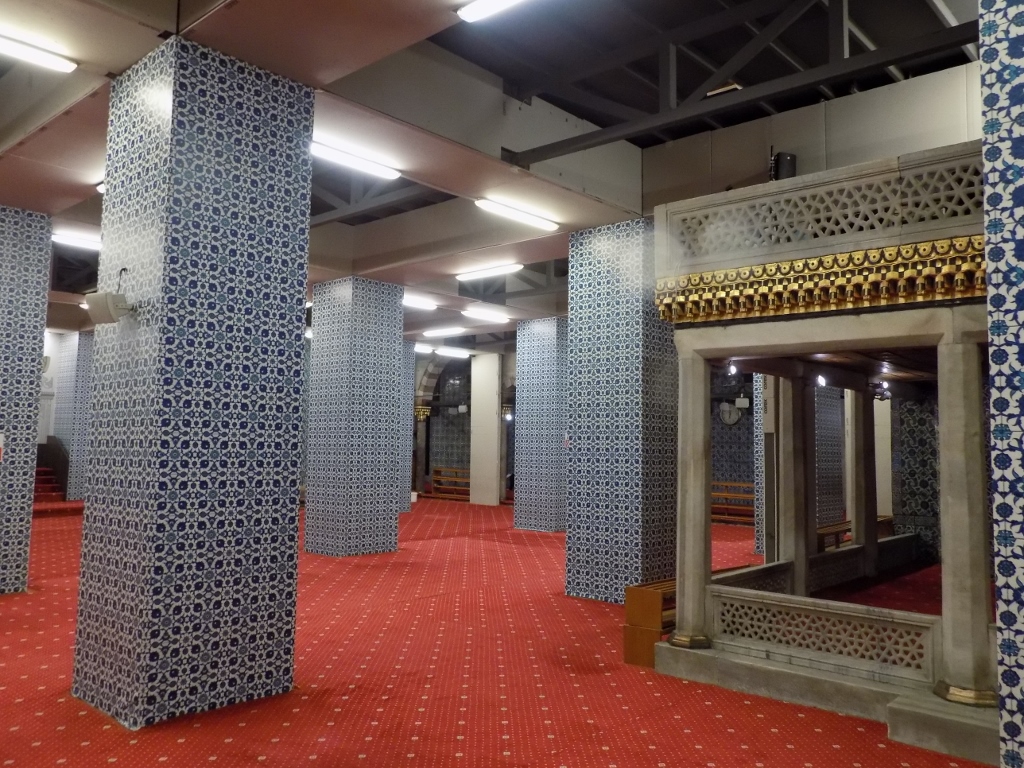 New Mosque, the interior at the time of the restoration
New Mosque, the interior at the time of the restoration
In the spacious square in which there is the New Mosque, there is also the Mısır Çarşısı, i.e., the Egyptian or the Spice Bazaar.
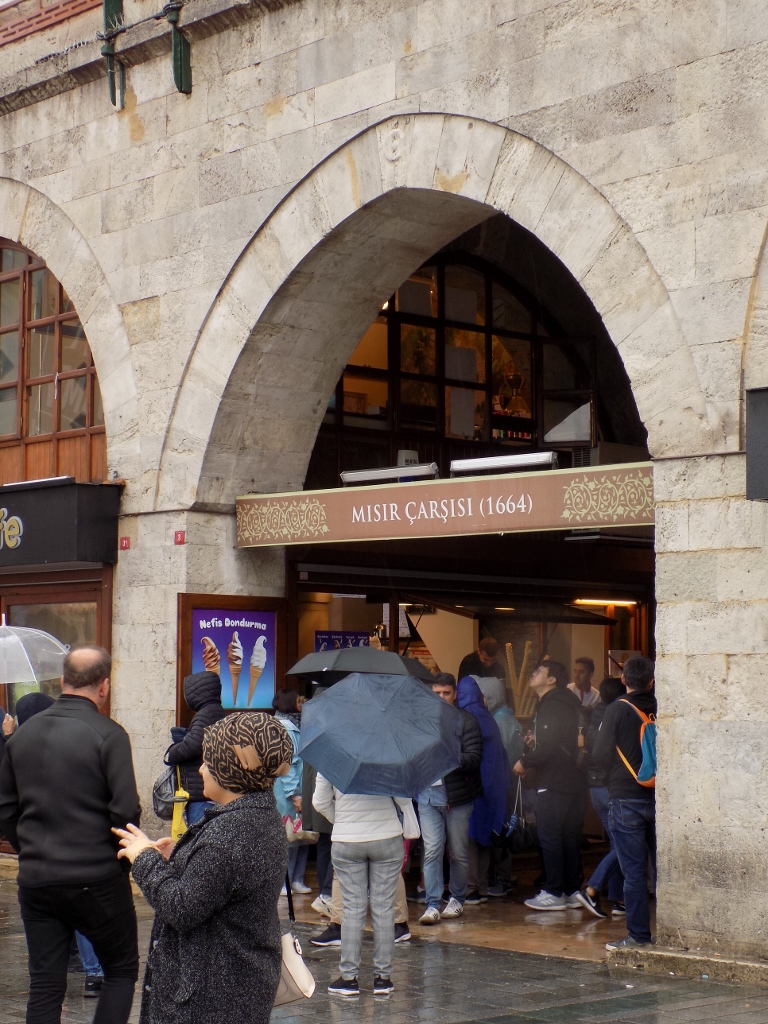 Mısır Çarşısı, one of the entrances
Mısır Çarşısı, one of the entrances
Of course, there is a much bigger offer, not only spices. After the Grand Bazaar that is also called Kapalıçarşı meaning a covered market (which is in a way a mistake since the Egyptian market is technically speaking also covered), this is the second largest covered market in Istanbul.
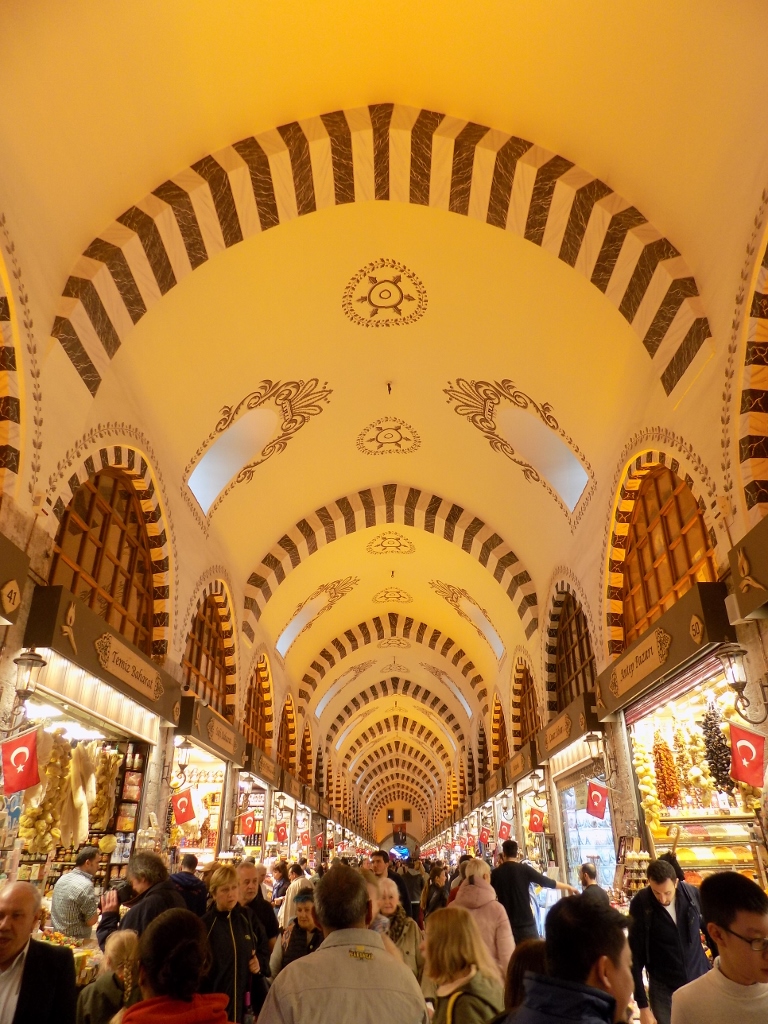 Mısır Çarşısı
Mısır Çarşısı
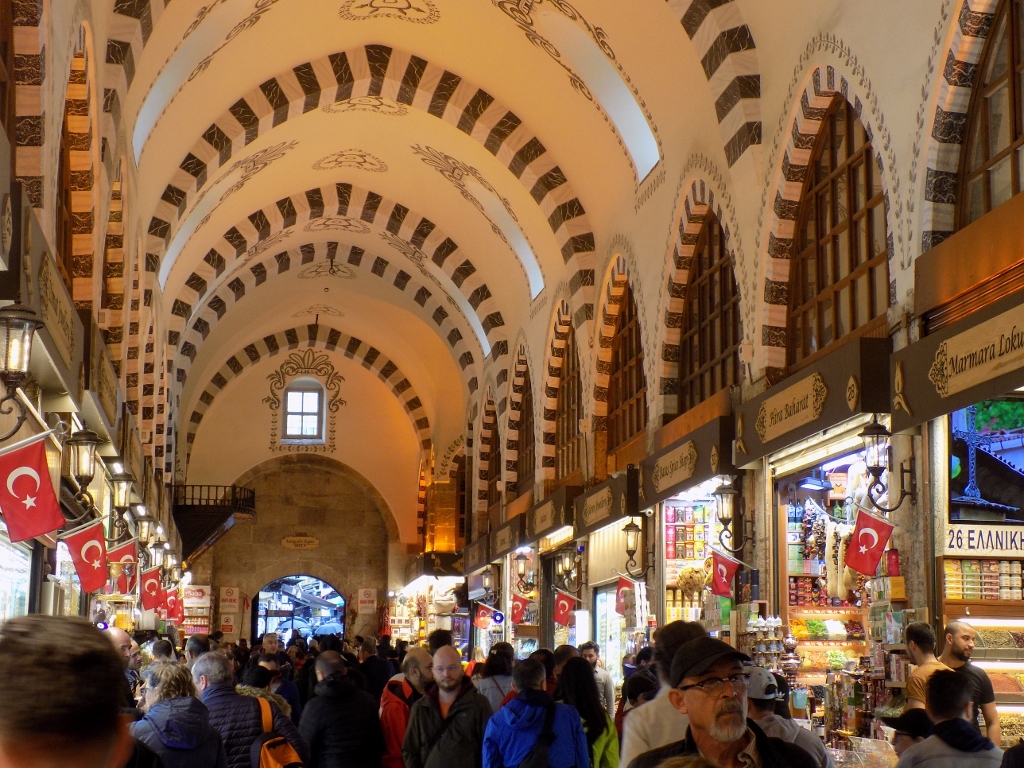 Mısır Çarşısı
Mısır Çarşısı
The offer is very diverse: in addition to spices and teas, there are also the unavoidable dried fruits in different versions, soaps and much, much more.
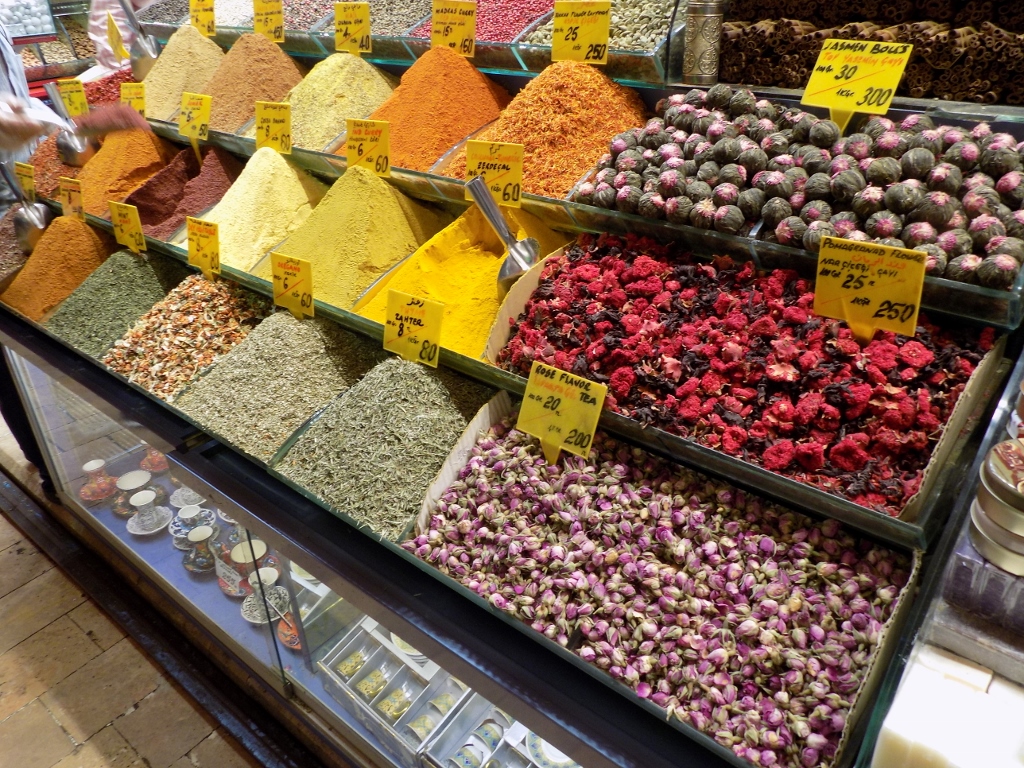 Offer at the Spice Market
Offer at the Spice Market
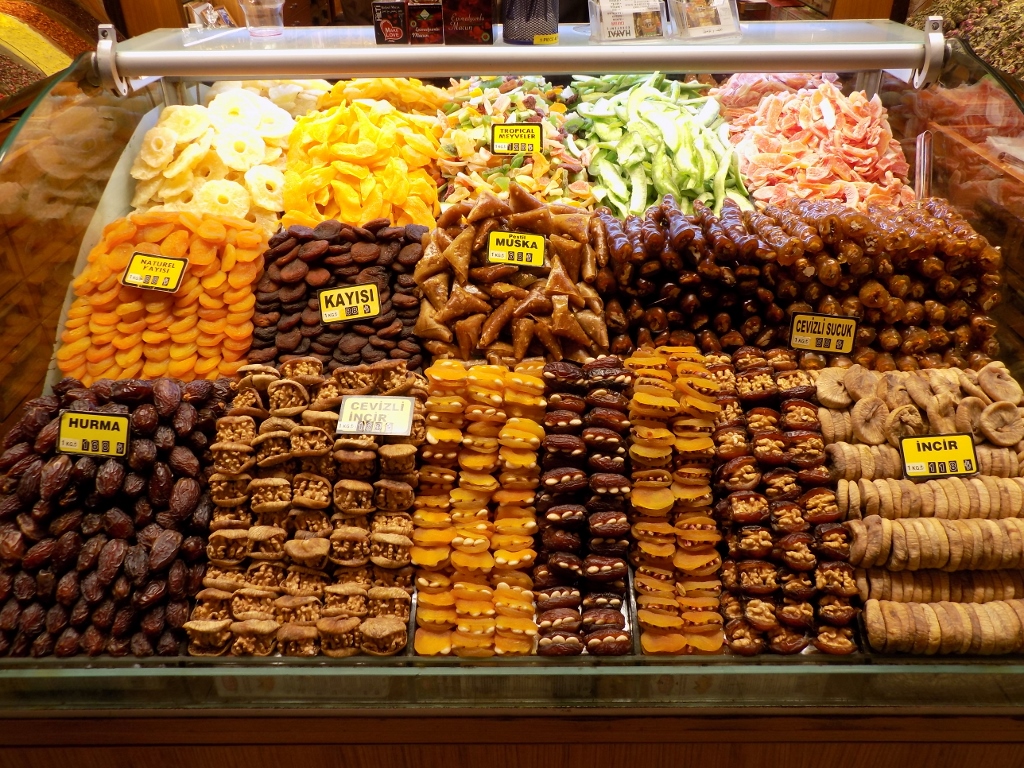 Offer at the Spice Market
Offer at the Spice Market
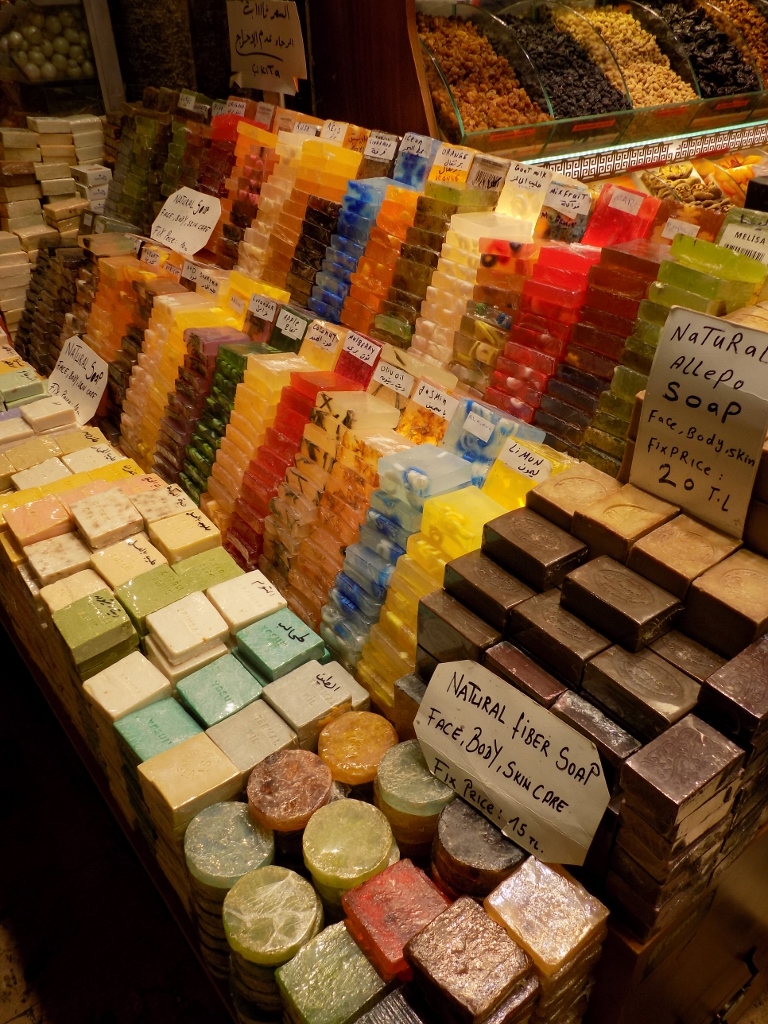 Offer at the Spice Market
Offer at the Spice Market
The market’s plan has the L-shape and when we exited at the other end, we came across another big and impressive türbe. This is the sepulchre of Turhan Hatice Sultan (1627-1683), who was first the Haseki Sultan (the chief/favourite consort of a sultan) and the Valide Sultan (“the legal mother,” mother of the ruling sultan – a VERY important and often exceptionally influential role). It is quite clear from the tomb that this was not meant for any ordinary person.
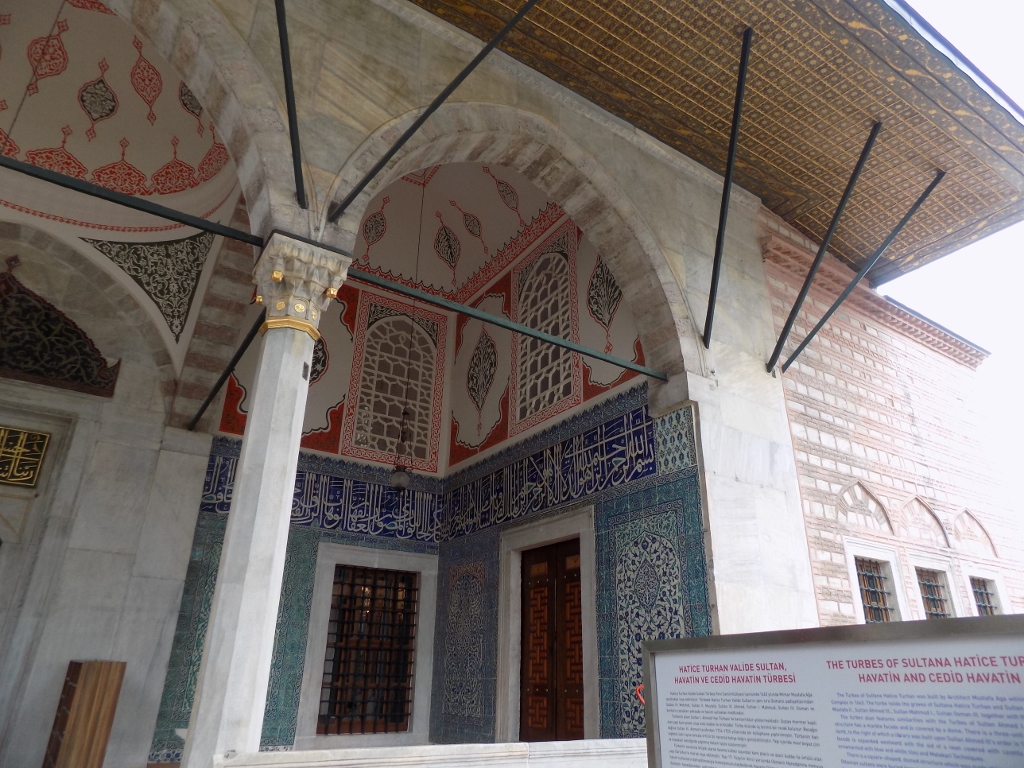 Türbe of Turhan Hatice Sultan
Türbe of Turhan Hatice Sultan
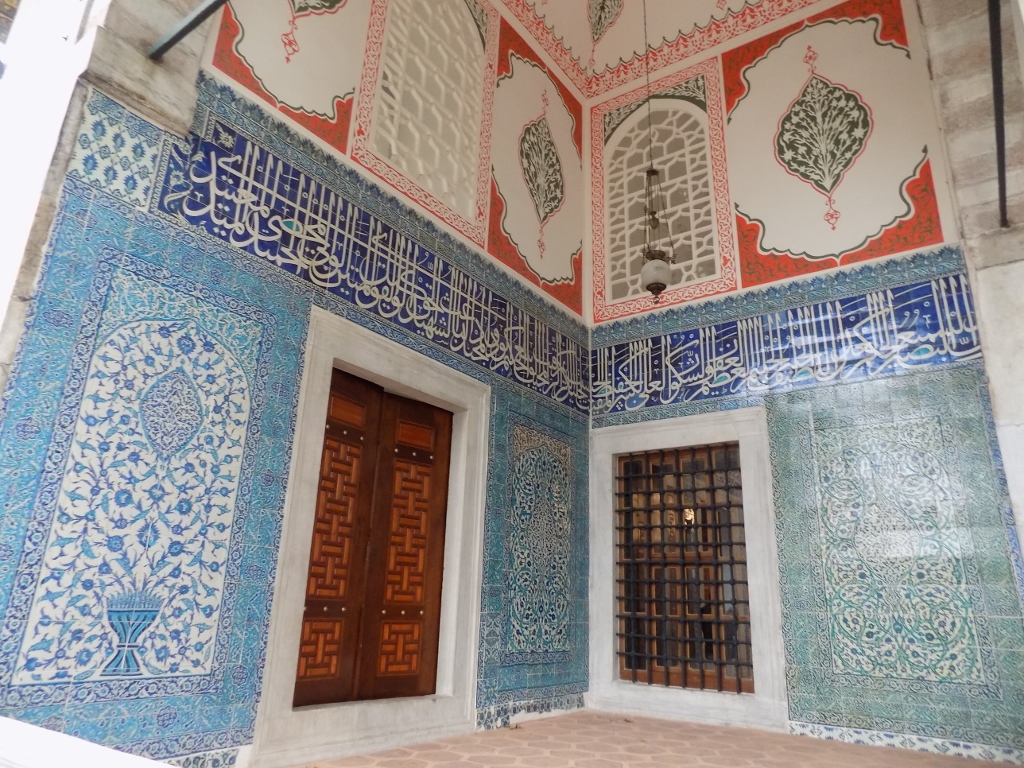 Türbe of Turhan Hatice Sultan
Türbe of Turhan Hatice Sultan
After this, it was the high time to sit down and have a bite, since we got tired from all this walking. This time we went to one of the numerous restaurants on the Galata Bridge where it is possible to eat the famous “balik ekmek,” i.e., a sandwich with a nice piece of grilled fish.
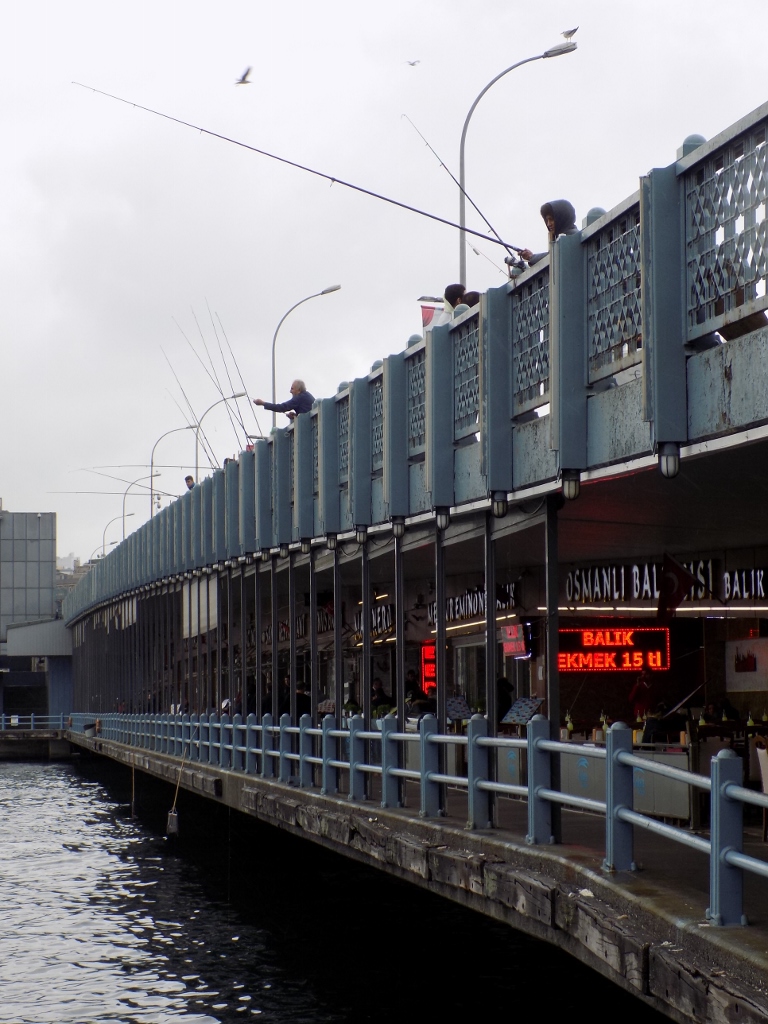 Galata Bridge
Galata Bridge
This certainly was nothing spectacular, but it was tasty, right on time and in sufficient quantity. On the other hand, with this we checked off yet another thing that had been recommended to us.
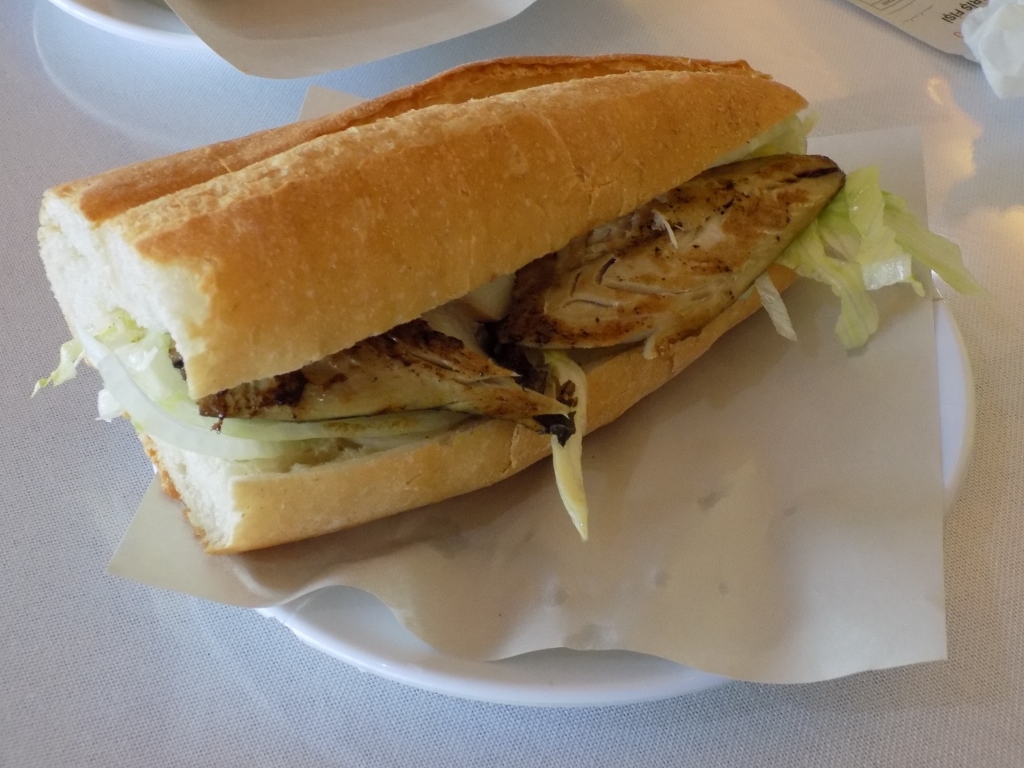 Balik ekmek (fish bread)
Balik ekmek (fish bread)
Galata Bridge that spans across the narrow and rather long Golden Horn bay has two floors – the upper one is used for the passage of vehicles, while on the lower one there are numerous restaurants on both sides and there is also a wide passage for pedestrians. In addition to these data, it is important that there are wonderful views from there.
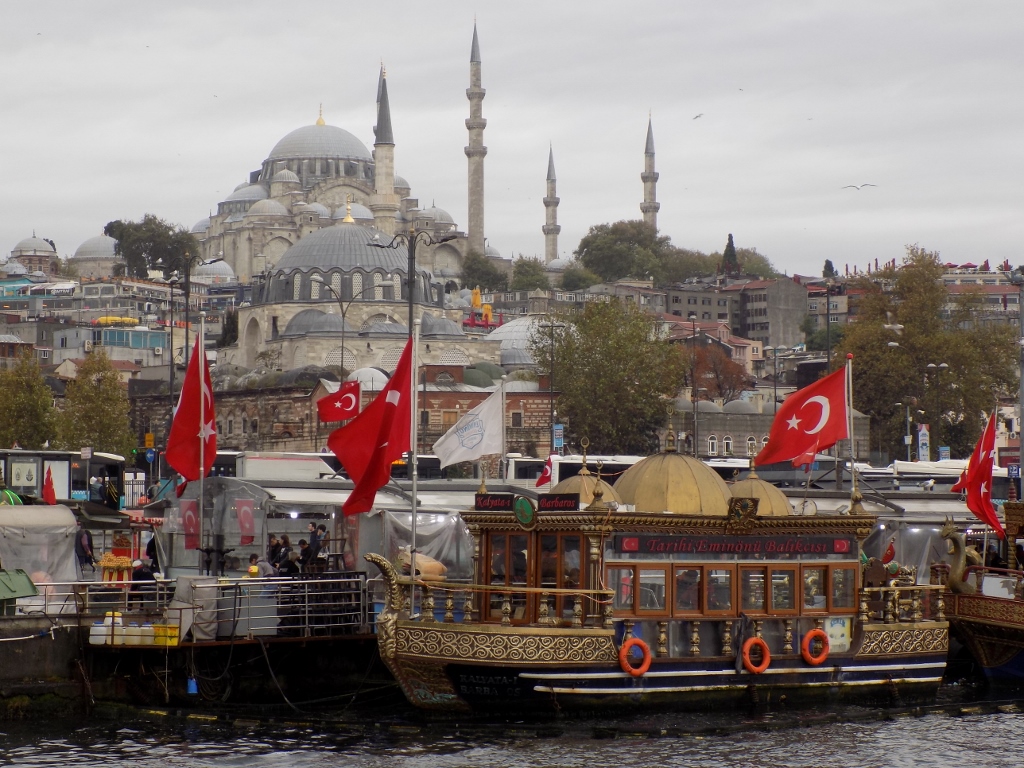 View at the Süleymaniye Mosque
View at the Süleymaniye Mosque
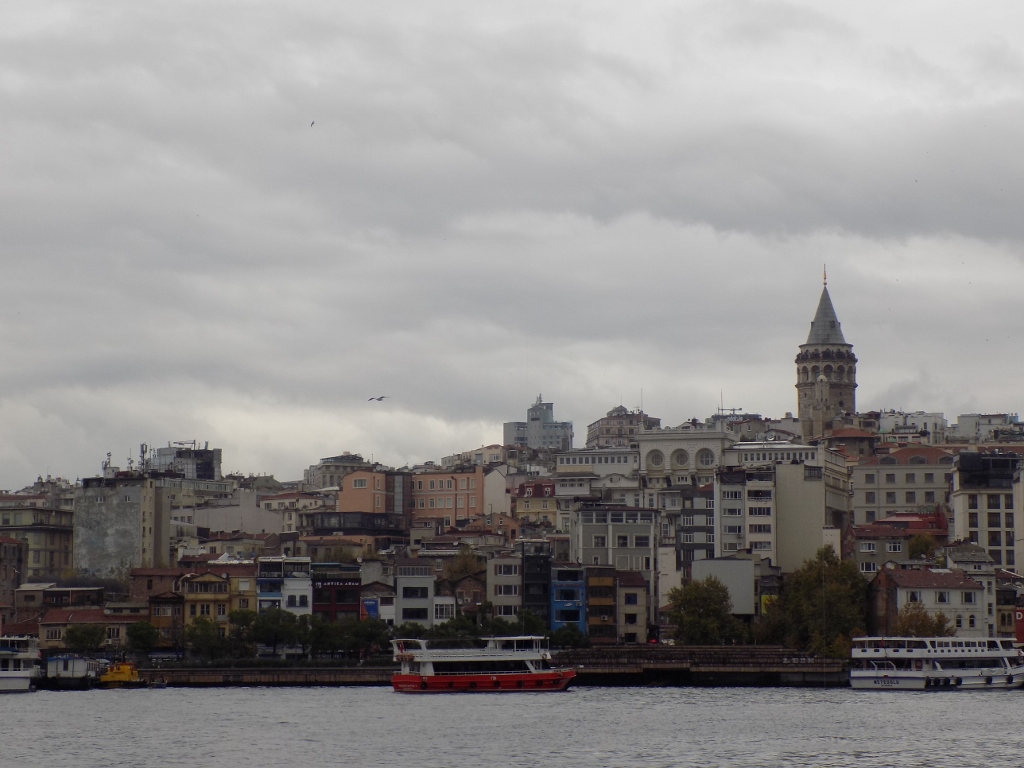 View at the Galata Tower
View at the Galata Tower
When you cross to the other side you can beautifully see again the part of the city called Eminönü.
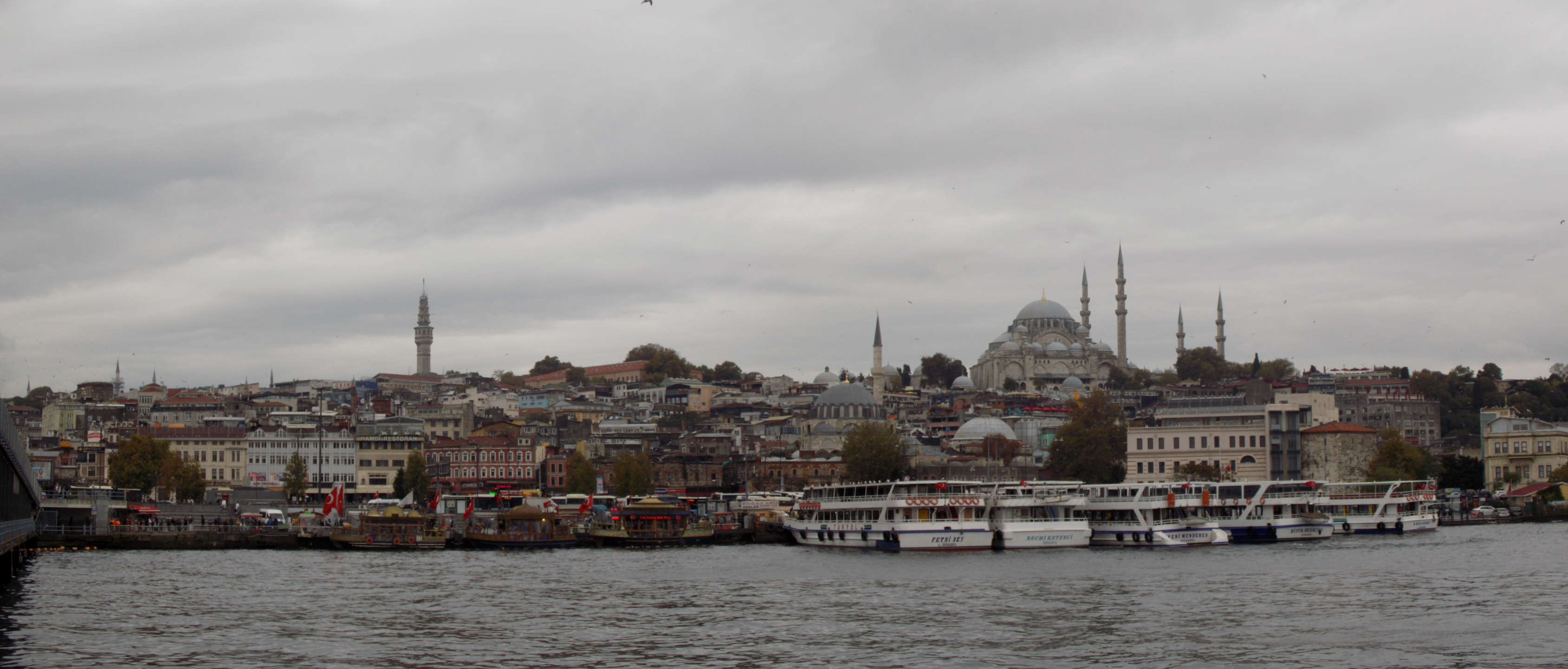
On the other side of the bridge we immediately got off it and there we came across a fish market. There are several restaurants as well, so it is certainly possible to eat there, while at the same time seeing what is on offer and how fresh it is.
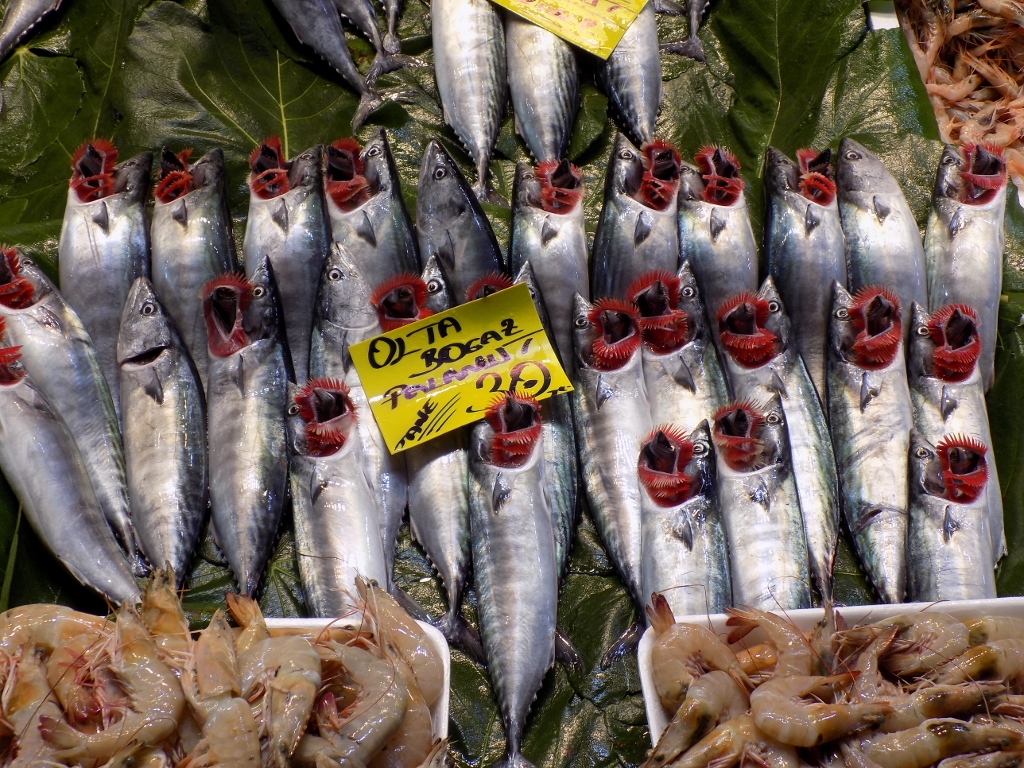 Fish market in the part called Karaköy
Fish market in the part called Karaköy
Visitors usually come here in order to continue straight to the top of the hill where the Galata Tower and other places of interest are located, but our plan was somewhat different – we were looking for a specific mosque, while on our way we came across another one that is very interesting in its own right. This is the Arap Mosque.
One of the versions of the historic events linked to this place says that the first religious edifice built here was a 6th-century church, but it is much more important, and hence its name, that at the beginning of the 8th century the Islam Arab army built their mosque here and the first Muslim call for prayer in Constantinople was voiced precisely from this mosque. After seven years of active use of the mosque, it was abandoned (since the Arab army retreated, as they had other things to attend to in Damascus) and then it moved into the hands of the Dominican order and became a part of a monastery. The building was then called St. Paola and when the Ottomans conquered Constantinople (in 1453) it got back its original name.
The other version says that at the end of the 15th century Arabs from Andalusia came here when the Spaniards expelled them from there, but somehow I find the first version more interesting.
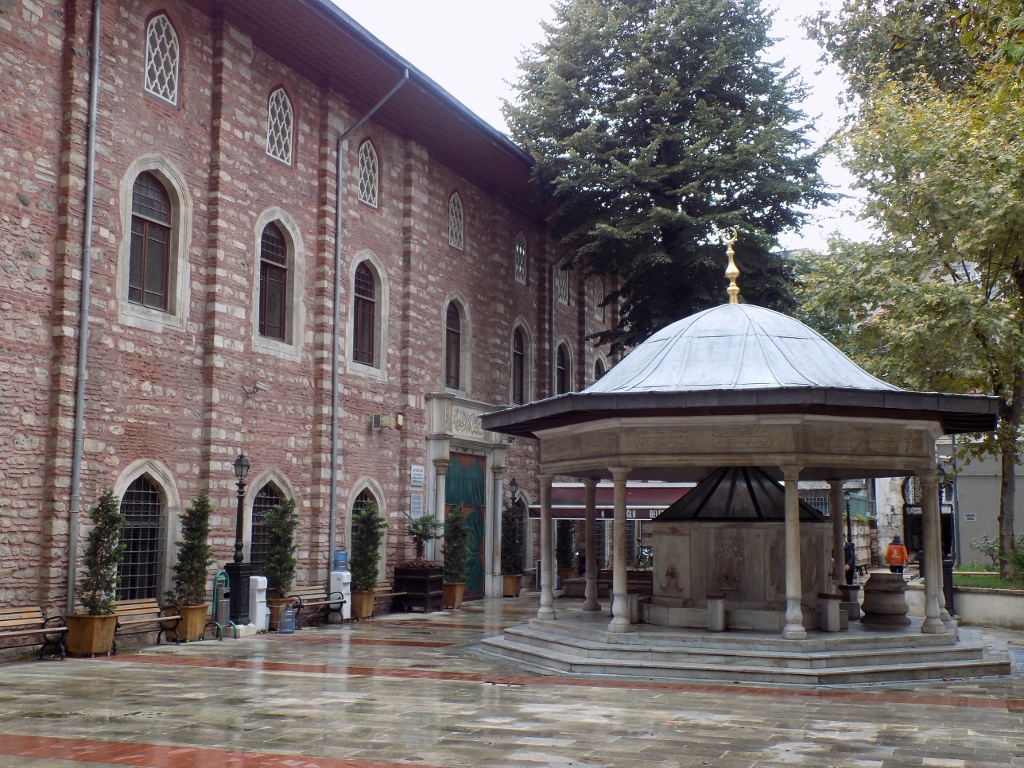 Shadirvan in front of the Arap Mosque
Shadirvan in front of the Arap Mosque
This mosque is surrounded by narrow streets and it is somehow difficult to get a true impression about the building, but from one of the side passages where the old manner of construction may be seen, one can also get a glance at the minaret which was originally, at the time of the Dominicans, built to serve as a bell-tower.
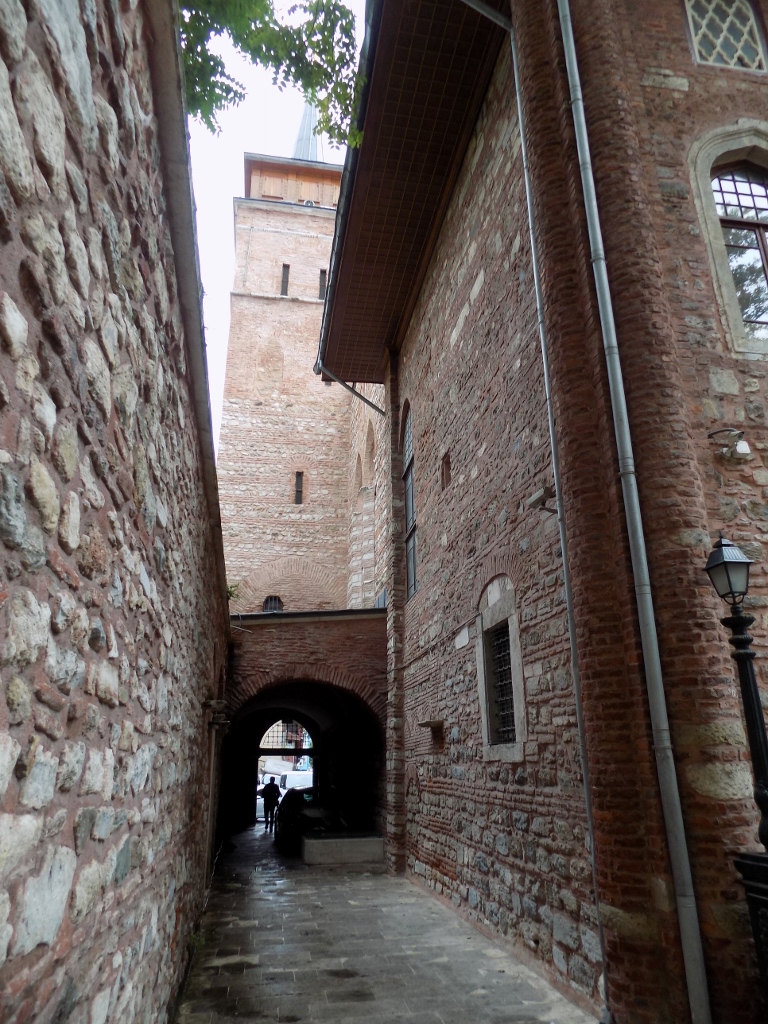 Minaret of the Arap Mosque
Minaret of the Arap Mosque
Following this small detour, we returned to the main street leading parallel to the Golden Horn and headed straight in line with our plan, but we also passed by a restaurant that was already making sandwiches with lamb’s intestines – the kokoreç. I know it may sound incredible, but I could not eat any more at that point in time, since the fish sandwich had just started to digest, so I only took a photo.
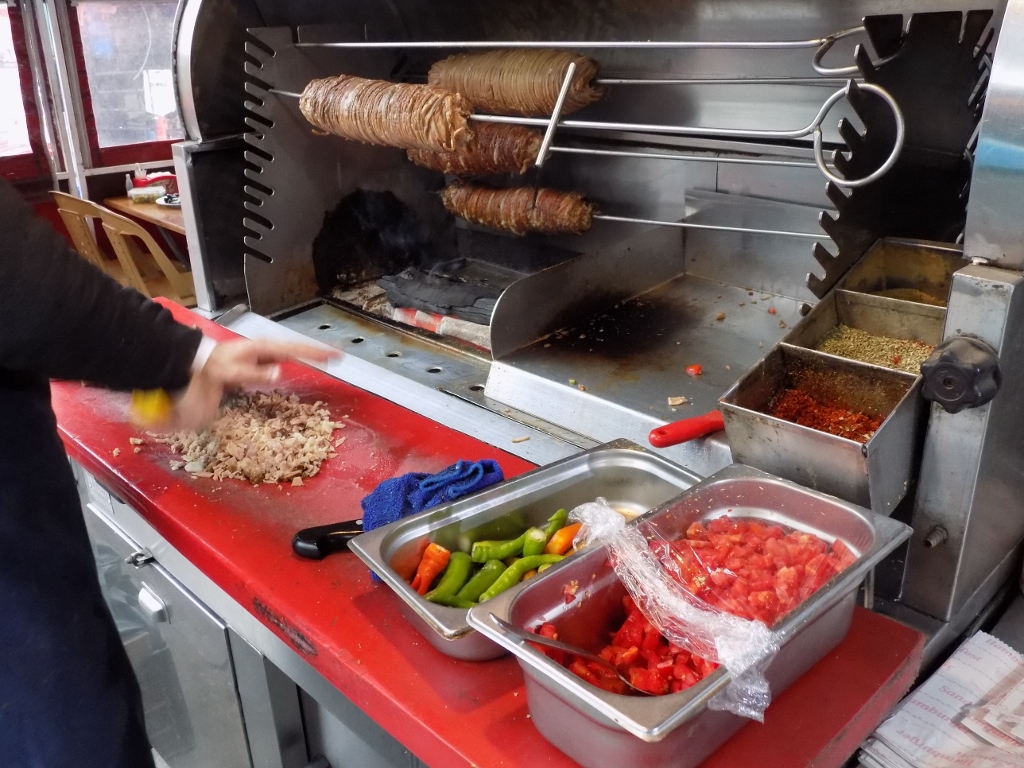 Before putting them into a sandwich, the well roasted lamb’s intestines are first finely diced
Before putting them into a sandwich, the well roasted lamb’s intestines are first finely diced
The main reason why we went off the usual path followed by visitors after having crossed the Galata Bridge was that we wanted to visit one of the mosques built by our co-national of a sort, i.e., the famous Sokollu Mehmet Pasha, the main architect of which was also famous Mimar Sinan, the most distinguished architect of the Ottoman Empire.
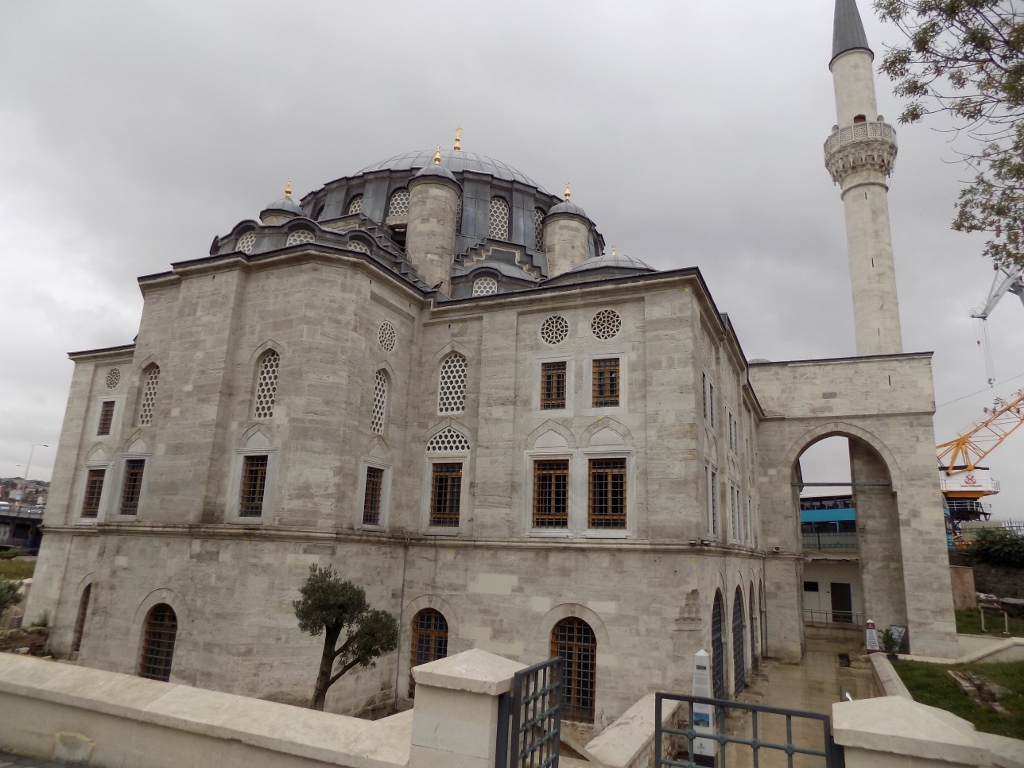 Sokollu Mehmet Pasha Mosque
Sokollu Mehmet Pasha Mosque
This mosque is often called the Azapkapi Mosque after the area in which it is located and that is proximity of the Atatürk Bridge. Since it was built in 1578 by the very sea (the Golden Horn bay), the minaret was constructed on the opposite side in relation to the water and it is also interesting that one needs to go up the stairs in order to get to the praying hall since it is positioned above the ground floor.
Like in all the mosques in which there was no ongoing restoration, the interior here was impressive as well.
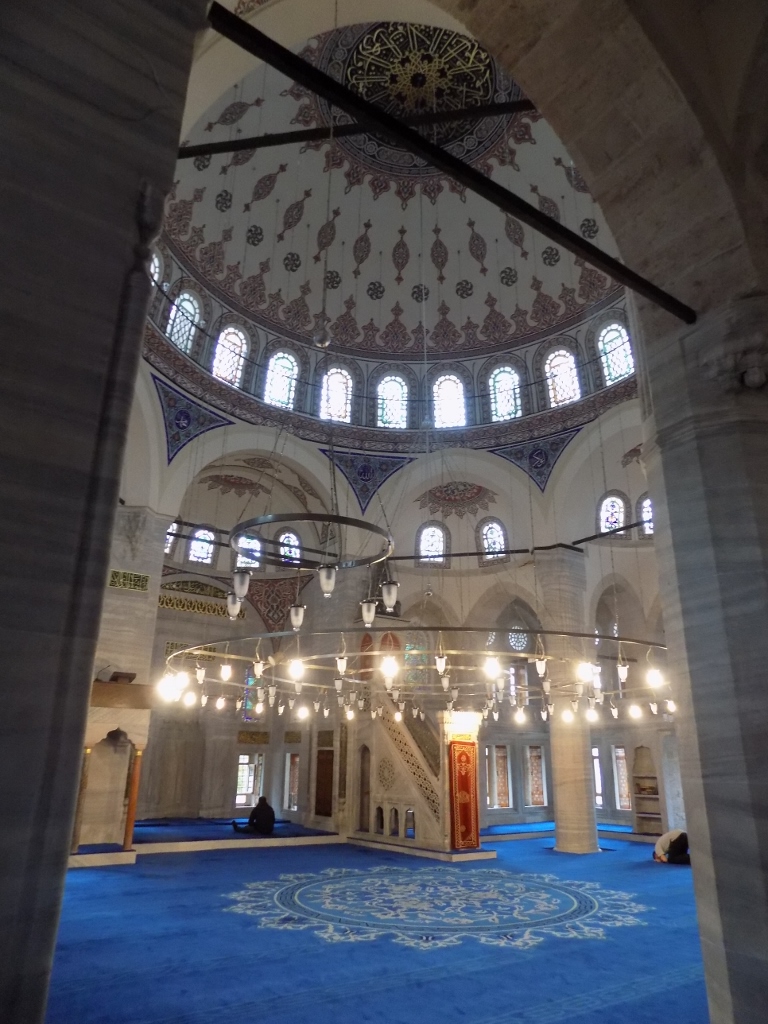 Sokollu Mehmet Pasha Mosque, the interior
Sokollu Mehmet Pasha Mosque, the interior
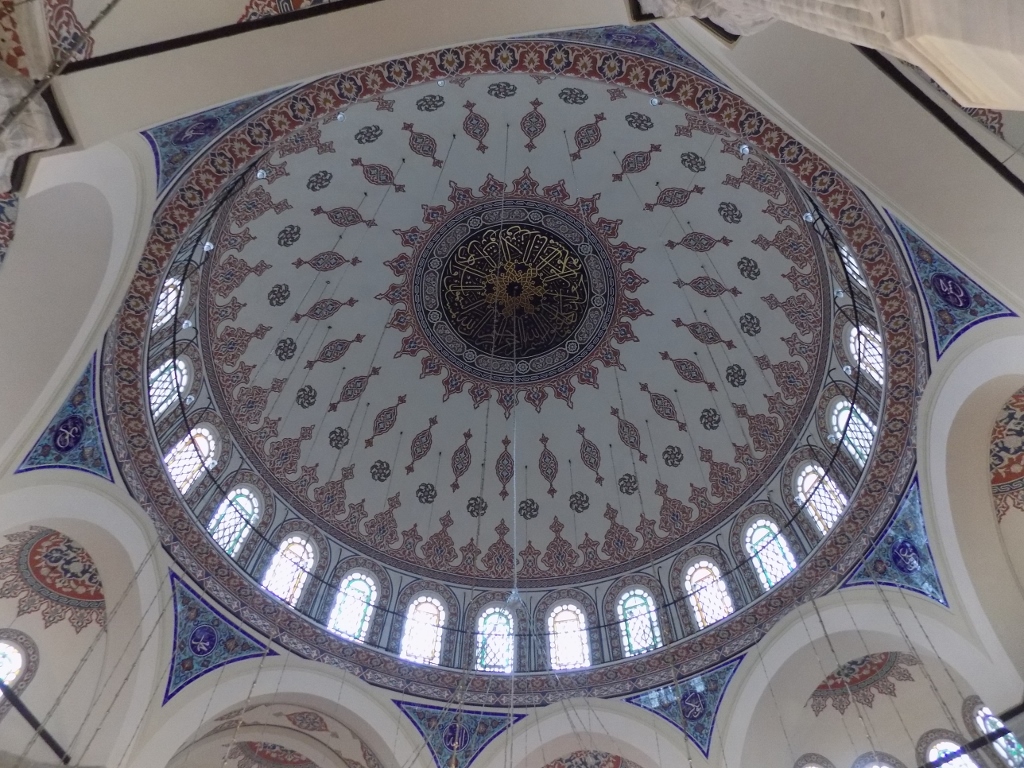 Sokollu Mehmet Pasha Mosque, the dome from within
Sokollu Mehmet Pasha Mosque, the dome from within
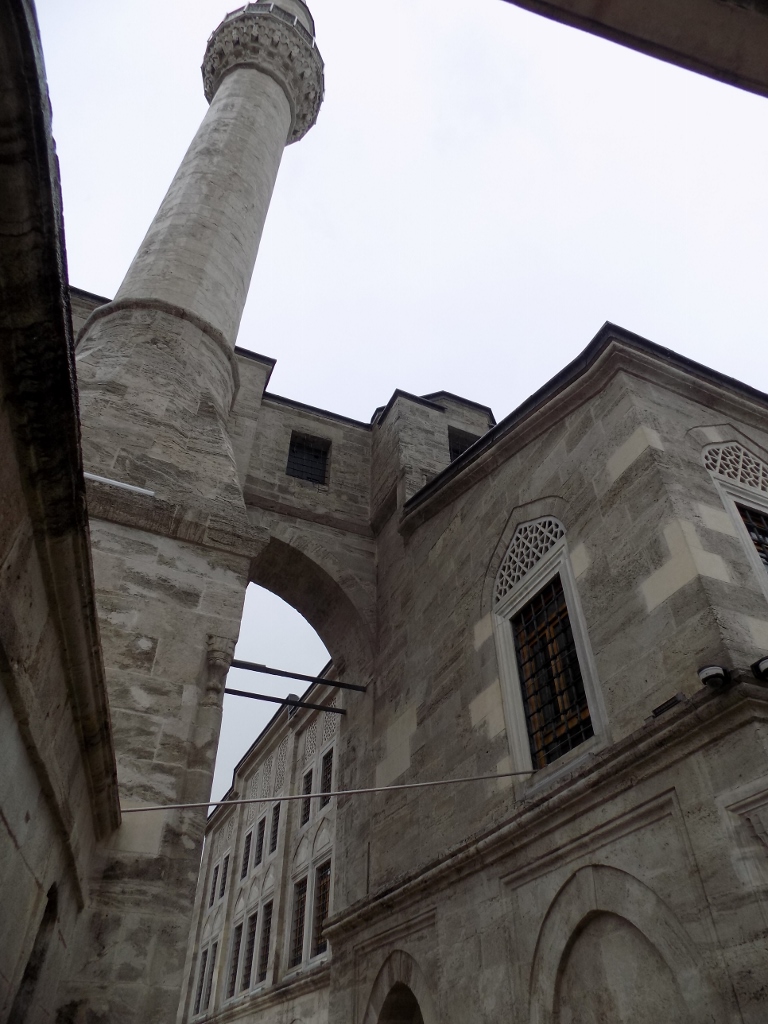 Sokollu Mehmet Pasha Mosque, minaret
Sokollu Mehmet Pasha Mosque, minaret
Since we managed to do exactly as we planned, afterwards we returned slowly to the usual tourist routes and there we first went to the funicular Tünel. This is a historical underground funicular that links the Karaköy and Beyoğlu quarters. The line is 573 m long and was opened in 1875. It remains operational and is a part of the city’s public transportation system. I have already said that the public transportation in Istanbul is great, but here it is also possible to see that it is interesting and imaginative!
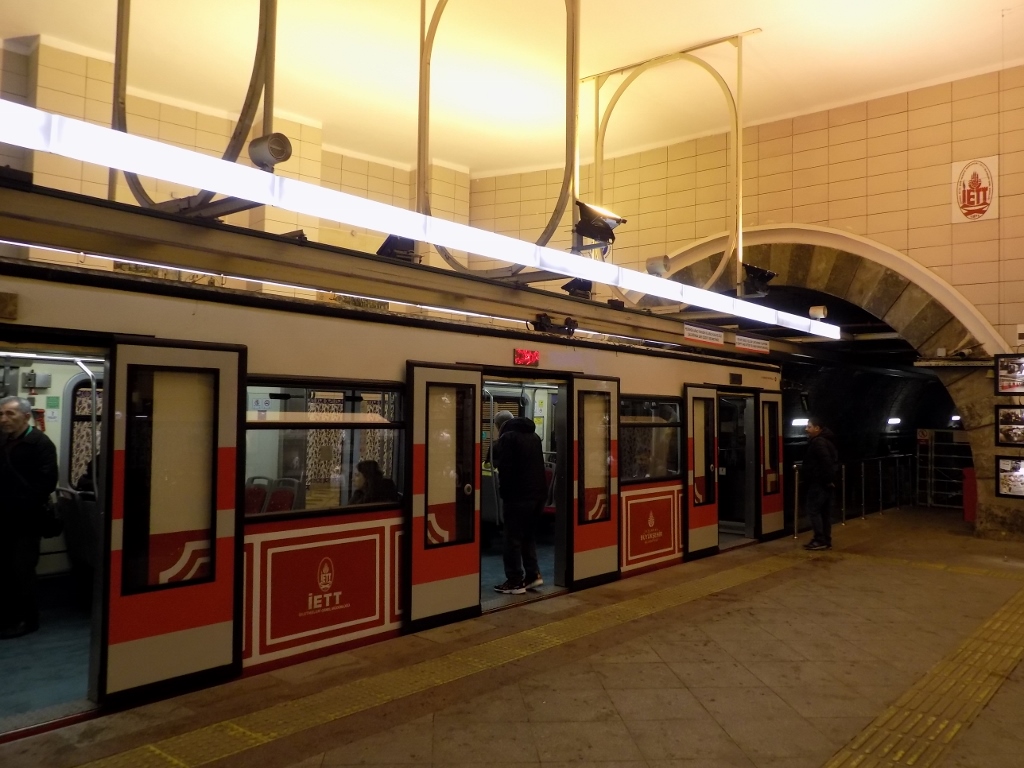 Funicular Tünel: ready to climb aboard
Funicular Tünel: ready to climb aboard
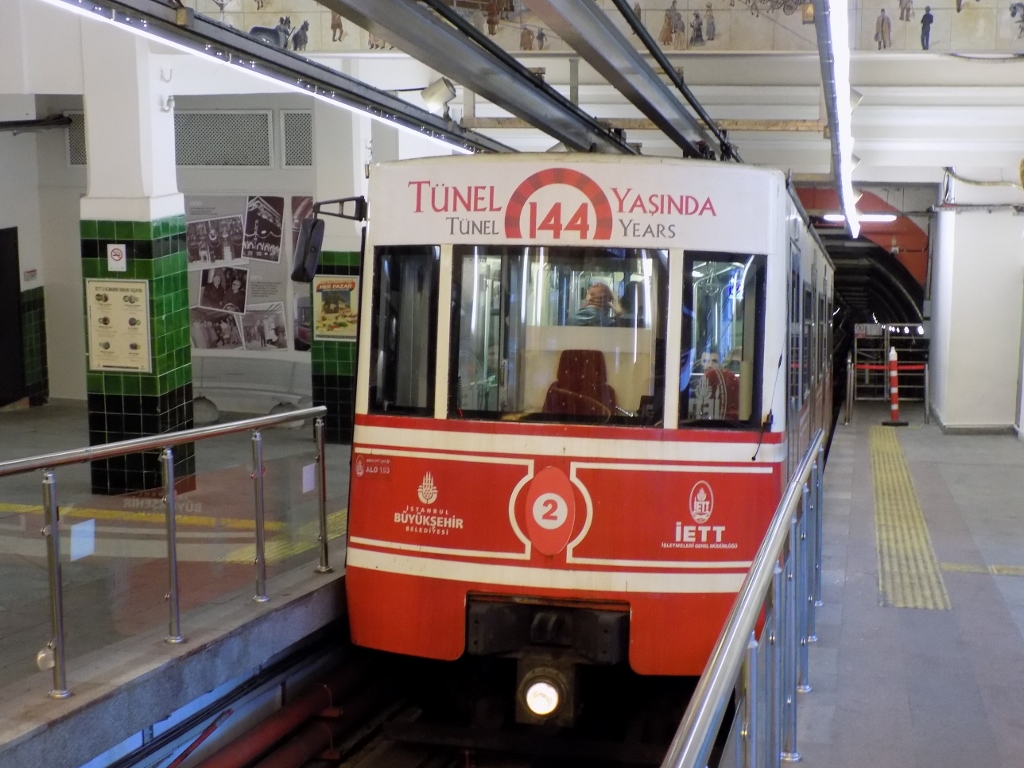 Funicular Tünel: we are now on the top of the hill
Funicular Tünel: we are now on the top of the hill
When we reached the top of Galata we were greeted by rain, but we headed for the Galata Tower anyway. On this occasion, Sneža was more ambitious than me and she said she would climb the top of the tower come what may. I looked at her incredulously, but she was very decisive with quite clear logic (“we are here now and who knows when again”), so I just followed suit. To my great relief and fortune, there was a contemporary lift there after all.
Galata Tower was built at the beginning of the 6th century and it was originally used as a lighthouse. From that time to the present it has been damaged several times, then repaired, added upon and heightened, and it got its final shape which we can see today in 1967. It has also been used for very different purposes: for the prisoners of war, as an observatory, as a fire-fighting watchtower, while the most fantastic data about it claims that it was from here that in 1638 Hezârfen Ahmed Çelebi famous Ottoman aviator (!!!) apparently flew over to Uskudar on the Asian side using the wings he had made himself.
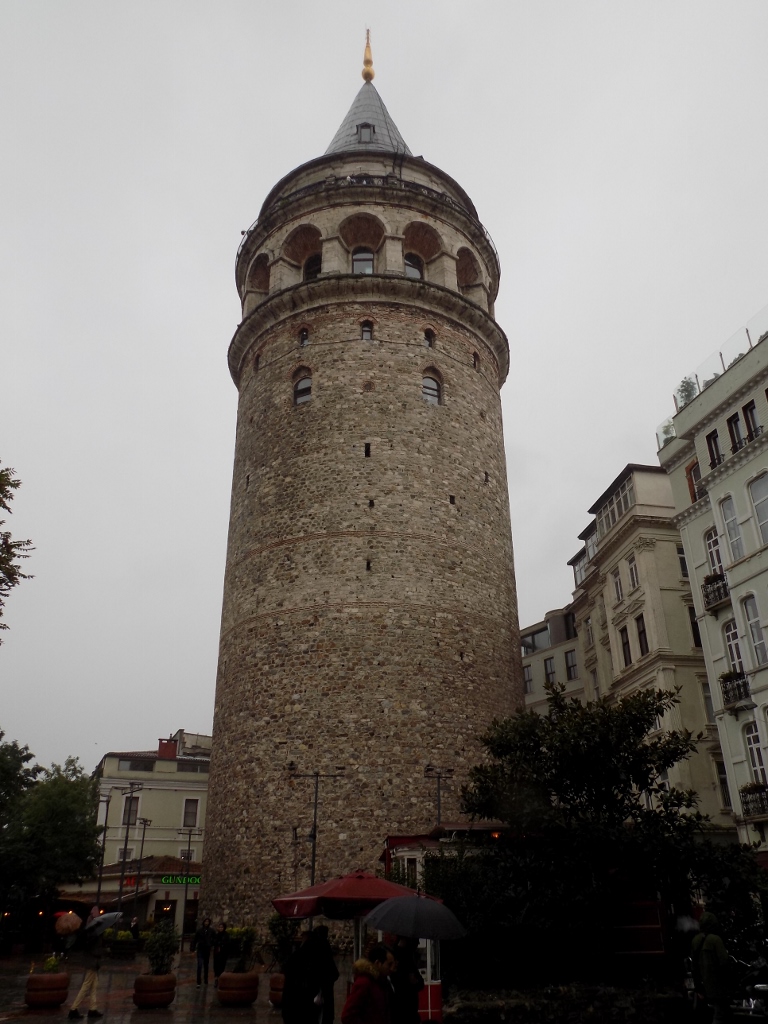 Galata Tower
Galata Tower
The tower is almost 70 metres tall, counting from its base, plus the altitude of the place where it was built, so the view from the circular terrace is impressive indeed even when it rains and there is a strong wind.
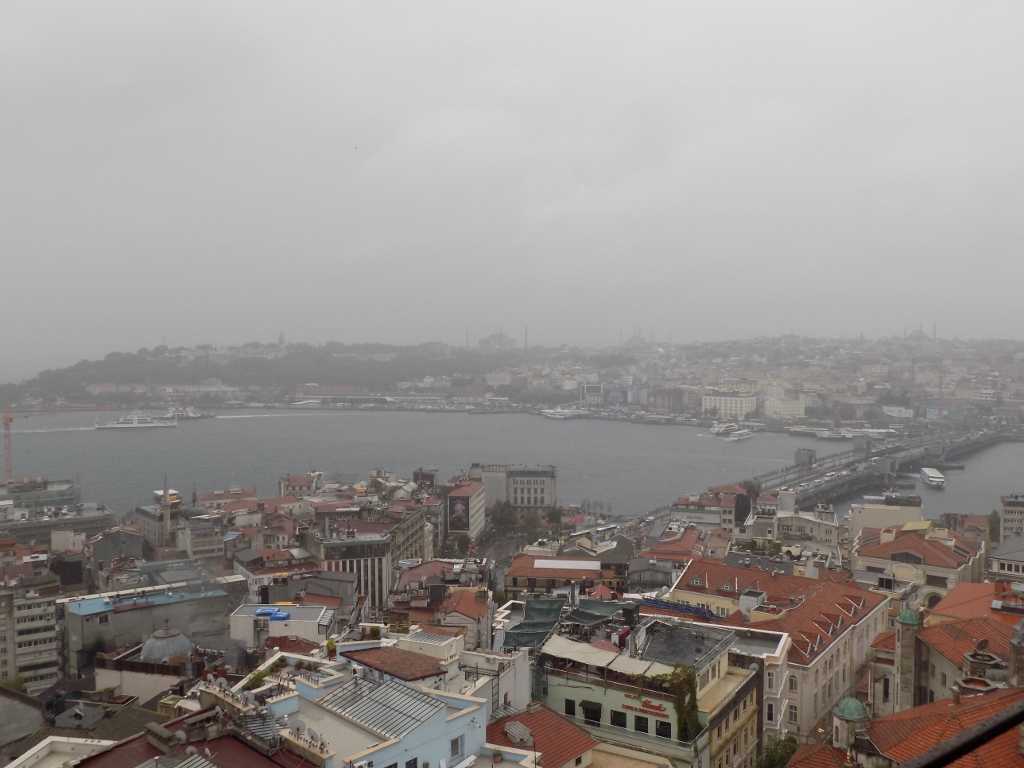 View from the Galata Tower at the Golden Horn and the historic centre of Istanbul
View from the Galata Tower at the Golden Horn and the historic centre of Istanbul
After we had made a circle on the terrace, I continued to hold on to the good old lift and descended in this way, while Sneža with a lot of determination walked down the stairs to the exit where we got together again and continued our visit to the area around the tower.
But, after the experience with the heavy rain and the strong wind, we thought it was the right time for a vitamin bomb in the form of juice made of freshly squeezed pomegranates and other fruits.
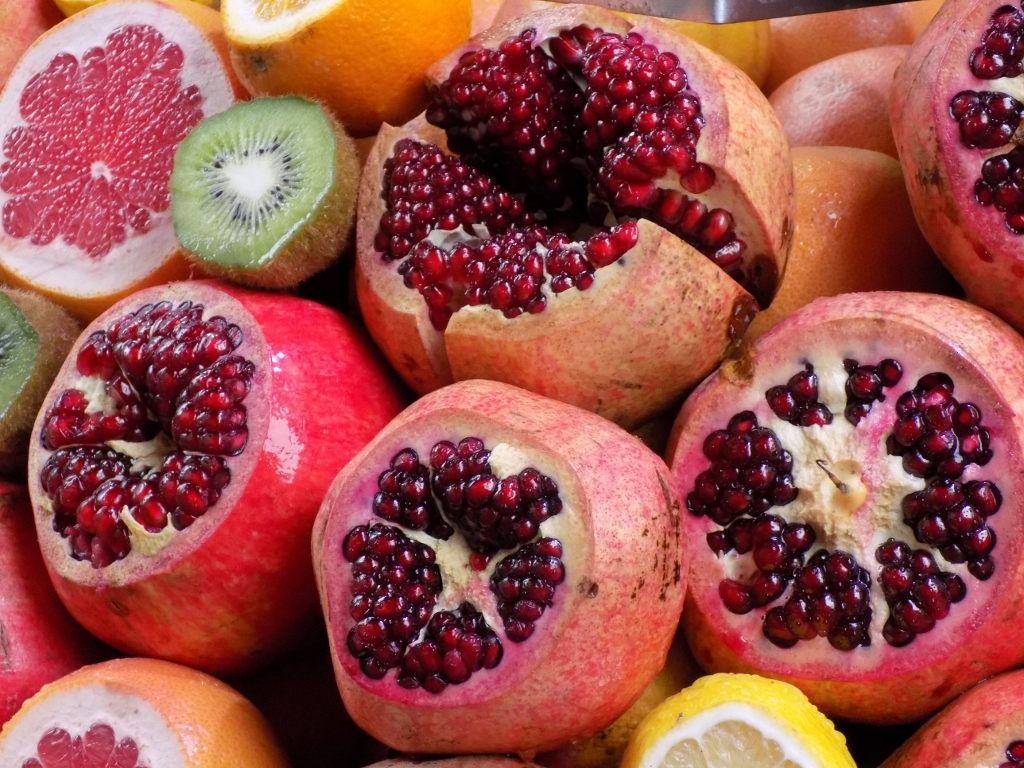 Fruits in one of the many shops that made fresh juices on the spot
Fruits in one of the many shops that made fresh juices on the spot